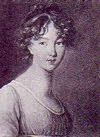
I have knit five of these caps (four are featured here) from Godey’s Lady’s Book and Magazine, April, 1858.

The pattern for “this useful little article” is very easy with alternate five row sections and colours of stocking and garter stitch. I put in an extra row in the beginning for support. Since there are five rows, the new colour cannot be carried up or over the section so I left a long loop behind the knitting each time I changed wool. I cut these in the middle when I finished and the tails became the gathering knot on each side at the end.

The puffy, lacy texture is created by knitting and dropping alternate stitches on the row before the cast/bind off row. The finished row, with fewer stitches, creates a firmer edge although the original pattern suggests that the cast-off row should be done loosely. The next step is to pull, from the middle of the cap outwards on each side, the dropped stitches. It is best to work the middle, then one side, then the other, and then back to the middle, repeating the process down the cap. I did not enjoy this part – it just feels dreadful to be tugging and pulling at the stitches. I would also recommend leaving two to three stitches unpulled on the sides as there is too much puffing out at the gathered section near the ears. The fringe was not much fun to make either but then I don’t like fringes and making them is extremely tedious. Other than that, this cap couldn’t be easier to knit and can be worked up in few hours.

The pattern suggests rosettes at the top of the ribbons although the illustration shows some sort of bow. Perhaps this is a style of mid-19th century rosette? I am not that fond of rosettes so I chose bows for my cap (burgundy/white, no fringe.) All of the other caps have rosettes that are more like small cockades as my skills were limited here. My cap rests around or over the bun of hair at the back.

The pattern required “the smallest size ivory needles” and “single Berlin wool.” These caps were knit on 3.25mm/3 US needles using Knit Picks’s Palette and Shadow Kettle Dyed (my cap.) The gathering on either side brings them up more narrowly than in the illustration. I am planning to make another one, with longer ribbons and a fringe, and not gather it tightly but let it drape more in the back to resemble the one in the original illustration. If anyone can suggest how I can create a shaggier fringe, as in the illustration, please let me know.


8 comments:
The fringe in the illustration looks bicolored; could it be that there is an under layer of longer, pale fringe and an over layer of shorter, dark fringe?
I have found your blog by searching for a knitting pattern for Miss Matty's shawl in Cranford Revisited. I know I am behind the times but it has only just been shown here in Norway. Did you ever knit one, or find any source of a pattern for somethig similar? I would love to knit one! Thanks, Gill.
Thanks, Tamar - that is a good suggestion and I will try that out in my next cap.
I have not found a pattern for Miss Matty's shawl but then I have not read through all of my 1840's patterns that carefully in the past year. I had originally planned to design it myself and then see if I could find one from that era that matched it. Keep checking back in case I do come up with something as I will definitely post all information here.
Thanks for reading!
Thank you for replying :) Gill
I just found your Blog. I was looking for historically correct patterns. You have quickly given me the guidance I needed. Thanks.
The yarn called for in the pattern is a Berlin -4thread, the fringe is split 2/2. Un twist a strand and use a blunt needle to divide it in two. I looks just like the picture this way.
Thank you, Susan, for the explanation.That is most helpful. I am going to re-do the fringes on all of the caps!
When you say to drop the stitches - do you mean they only get dropped at the last row of the knitting? Searching online for drop stitches shows wrapping the yarn around the needle a few extra times, but that is definitely not the same look you ended up with. Thanks!
Post a Comment